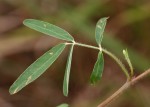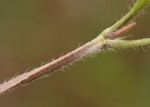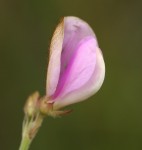Tephrosia lurida
Selected images: Click on each image to see a larger version and details of the record View all images (4)
Detailed records: Display species records QDS maps by: Google Maps Point records by Google Maps
Species details: Click on each item to see an explanation of that item (Note: opens a new window)
| Synonyms: |
Cracca lurida (Sond.) Kuntze Tephrosia angustissima Engl. Tephrosia dowsonii Baker f. Tephrosia longipes Meisn. var. lurida (Sond.) J.B. Gillett |
| Common names: | |
| Frequency: | |
| Status: | Native |
| Description: |
Perennial with prostrate or more often ascending stems, up to 50 cm high, growing from a woody rootstock; stems and leaf-rhachis sparsely or less often densely appressed pubescent with greyish hairs. Leaves mostly 3–7-foliolate; leaflets linear or narrowly lanceolate or oblanceolate, up to 12 cm long, usually less than 5 mm wide, ending in a stout blackish often recurved mucro, hairless above, appressed pubescent beneath; lateral veins very numerous; petiole up to 8 cm long, usually longer than the rhachis; stipules narrowly triangular, up to 1 cm long, often blackish. Flowers in very lax, terminal pseudoracemes; bracts linear, up to 7 mm long; pedicels 3–5 mm long. Calyx brownish pubescent; teeth triangular, about as long as the tube or slightly longer. Corolla pink or purple; standard 12–18 mm long; keel hairless. Pod ascending, slightly upcurved, 5–6 cm long and 4–5 mm wide, stiffly and shortly white spreading pubescent; style-base straight. |
| Type location: |
|
| Notes: | This species was long considered another variety under the variable Tephrosia longipes but is now considered separate again. |
| Derivation of specific name: | |
| Habitat: | In Grassland and rocky places. |
| Altitude range: (metres) | 1270 - 1830 m |
| Flowering time: | |
| Worldwide distribution: | Angola, DRC, Burundi, Kenya, Tanzania, Zambia, Zimbabwe, South Africa and Eswatini. |
| FZ divisions: | N,W,C,E |
| Growth form(s): | |
| Endemic status: | |
| Red data list status: | |
| Insects associated with this species: | |
| Spot characters: | Display spot characters for this species |
| Images last updated: | Sunday 19 September 2021 |
| Literature: |
Brummitt, R.K., Harder, D.K., Lewis, G.P., Lock, J.M., Polhill, R.M. & Verdcourt, B. (2007). Leguminosae Subfamily Papilionoideae Flora Zambesiaca 3(3) Pages 173 - 176. Drummond, R.B. (1972). A list of Rhodesian Legumes. Kirkia 8(2) Page 227. as Tephrosia lurida lurida Mapaura, A. & Timberlake, J. (eds) (2004). A checklist of Zimbabwean vascular plants Southern African Botanical Diversity Network Report No. 33 Sabonet, Pretoria and Harare Page 51. As Tephrosia lurida var. lurida Ntore, S. & al. (2024). Checklist of the vascular plants of Burundi Page 134. |
Other sources of information about Tephrosia lurida:
Our websites:
Flora of Burundi: Tephrosia luridaFlora of Zambia: Tephrosia lurida
External websites:
African Plants: A Photo Guide (Senckenberg): Tephrosia luridaAfrican Plant Database: Tephrosia lurida
BHL (Biodiversity Heritage Library): Tephrosia lurida
EOL (Encyclopedia of Life): Tephrosia lurida
GBIF (Global Biodiversity Information Facility): Tephrosia lurida
Google: Web - Images - Scholar
iNaturalist: Tephrosia lurida
IPNI (International Plant Names Index): Tephrosia lurida
JSTOR Plant Science: Tephrosia lurida
Mansfeld World Database of Agricultural and Horticultural Crops: Tephrosia lurida
Plants of the World Online: Tephrosia lurida
Tropicos: Tephrosia lurida
Wikipedia: Tephrosia lurida



